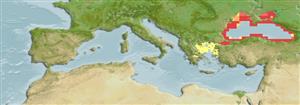Classification / Names
Common names from other countries
Main reference
Size / Weight / Age
Max length : 220 cm TL male/unsexed; (Ref. 9988); common length : 125 cm TL male/unsexed; (Ref. 3397); max. published weight: 80.0 kg (Ref. 9988); max. reported age: 27 years (Ref. 6866)
Length at first maturity
Lm ?, range 120 - ? cm
Environment
Marine; freshwater; brackish; demersal; anadromous (Ref. 51243); depth range 10 - 100 m
Climate / Range
Temperate; 10°C - 20°C (Ref. 2059), preferred 9°C (Ref. 107945); 61°N - 36°N, 22°E - 54°E
Distribution
Eurasia: Caspian, Black, Azov and Aegean Seas, ascending rivers to spawn. Occurrence in Albania needs confirmation. Introduced in Aral Sea. Artificially propagated (Ref. 6866). Probably extirpated from Aegean Sea and related river basins (Ref. 113969). Appendix III of the Bern Convention (protected fauna).
Countries | FAO areas | Ecosystems | Occurrences | Introductions
Short description
Dorsal
spines
(total): 0;
Dorsal
soft rays
(total): 40-46;
Anal
soft rays: 24 - 29. Snout long, pointed at tip. Lower lip not continuous, interrupted at center. Barbels short not reaching mouth but nearer to it than to tip of snout. Five rows of scutes, dorsal 11-14, lateral 30-36 on each side, ventral 10-11 on each side, with small bony stellate plates and smaller grains between main scute rows. Back dark grey to almost black, flanks lighter, belly white.
IUCN Red List Status (Ref. 115185)
Threat to humans
Harmless
Human uses
Fisheries: commercial; aquaculture: commercial; aquarium: public aquariums
Tools
Special reports
Download XML
Internet sources
Estimates of some properties based on models
Phylogenetic diversity index
PD50 = 0.5000 many relatives (e.g. carps) 0.5 - 2.0 few relatives (e.g. lungfishes)
Trophic Level
3.5 ±0.2 se; Based on diet studies.
Resilience
Low, minimum population doubling time 4.5 - 14 years (K=0.06; tm=9; tmax=27; Fec=20,000-360,000)
Vulnerability
High vulnerability (64 of 100)
Price category
